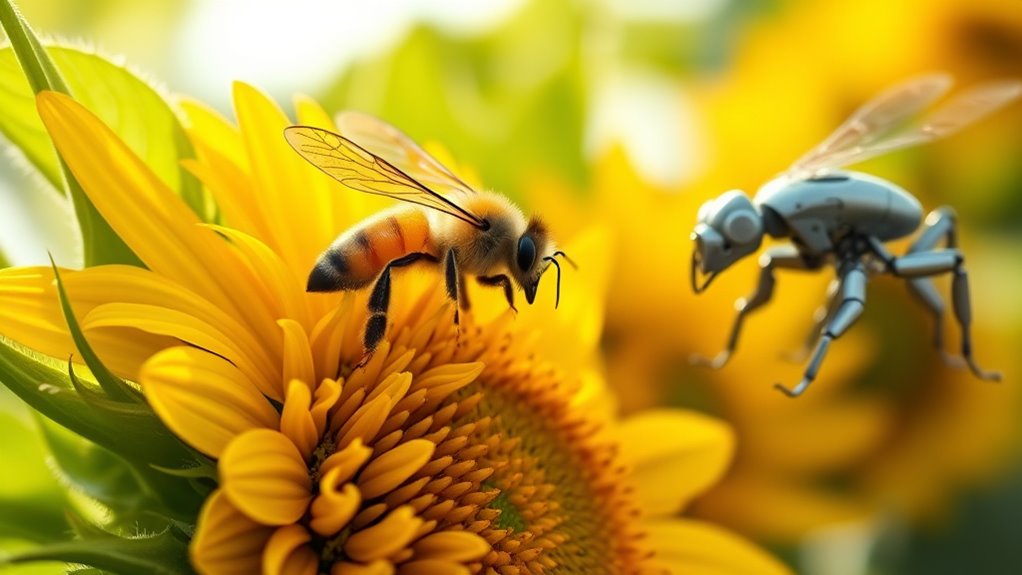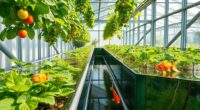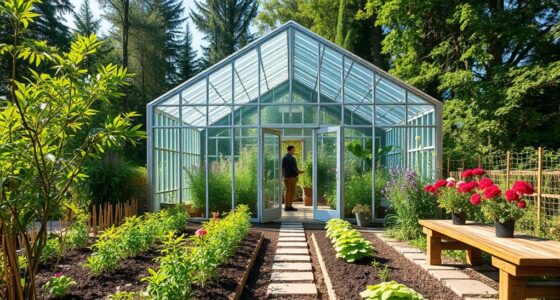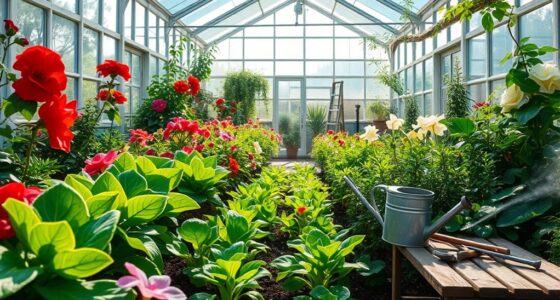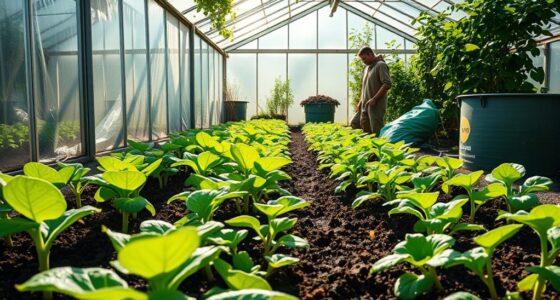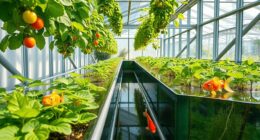You rely on different pollination strategies like bees, bots, and brushes to help plants reproduce successfully. Natural bees transfer pollen between flowers, supporting biodiversity and crop production. When bees are scarce, humans use manual tools or robotic devices to mimic natural pollination. Combining these methods can improve plant yields and ecosystem health. If you want to know more about how these strategies work together, keep exploring the various techniques involved.
Key Takeaways
- Bees are natural pollinators that effectively transfer pollen between flowers in ecosystems and agriculture.
- Bots or mechanical pollination devices mimic natural pollination, especially when pollinator populations decline.
- Brushes are manual tools used in artificial pollination to transfer pollen precisely, often in controlled environments.
- Combining bees, bots, and brushes enhances pollination reliability, supporting biodiversity and crop yields.
- Human intervention through urban beekeeping and artificial methods helps sustain pollination amid environmental challenges.

Pollination strategies are essential for plants to reproduce successfully, and different species have evolved a variety of methods to guarantee their pollen reaches the right flowers. In recent years, humans have also stepped in to assist these natural processes, especially in environments where plant populations are declining or where natural pollinators are scarce. Urban beekeeping has gained popularity as a way to support pollination in city environments, where flowering plants might otherwise struggle to thrive. By maintaining hives in urban settings, you help boost local bee populations, which are key pollinators for many crops and wildflowers. These bees transfer pollen from flower to flower, ensuring fertilization and fruit production. Urban beekeeping not only benefits the environment but also improves local food security and promotes biodiversity amidst concrete jungles.
However, sometimes natural pollinators aren’t enough, especially in highly urbanized areas or monoculture farms. That’s when artificial pollination comes into play. You might think of it as a kind of human-assisted pollination, where you manually transfer pollen to flowers using tools like brushes or even mechanical devices. This method is particularly common in commercial agriculture, where crop yields depend heavily on successful pollination. Artificial pollination can be a precise and efficient way to supplement natural processes, especially when bee populations decline due to pesticides, habitat loss, or disease. You can perform artificial pollination by gently brushing pollen from one flower’s anther onto the stigma of another, mimicking what bees do naturally. It’s a delicate task that requires understanding the timing and biology of each plant species, but it can dramatically increase fruit set and crop quality. Additionally, top-rated portable pollination tools can help enhance efficiency and consistency during manual pollination tasks.
Both strategies—urban beekeeping and artificial pollination—highlight how human intervention can support plant reproduction in modern landscapes. While bees remain the primary pollinators for many plants, you shouldn’t overlook the importance of manual methods when natural pollinators are absent or insufficient. Urban beekeeping plays a crucial role in maintaining healthy bee populations, but it’s not a complete solution on its own. Combining it with artificial pollination techniques allows for more reliable and controlled pollination, especially in controlled environments like greenhouses or urban farms. By understanding and employing these strategies, you actively contribute to the resilience of plant ecosystems, ensuring a continuous cycle of pollination that sustains biodiversity and food production in our increasingly urbanized world.
Frequently Asked Questions
How Do Different Bee Species Choose Their Preferred Flowers?
You might wonder how different bee species choose their preferred flowers. Bee preferences are shaped by flower traits like color, scent, and shape, which attract specific bees. For example, some bees prefer bright blue or yellow flowers with strong scents. By recognizing these traits, bees can efficiently gather nectar and pollen. Your understanding of bee preferences helps explain why certain flowers attract specific bee species, enhancing pollination success.
Can Robotic Pollinators Fully Replace Natural Bees?
You might think robotic pollinators could fully replace natural bees someday, but don’t be fooled. With robotic autonomy lacking the complex understanding of bee behavior, these machines can’t replicate the nuanced role bees play. While they might help in some scenarios, they can’t match the adaptability and instinctual precision of real bees. So, as much as technology advances, nature’s pollinators still hold a crucial, irreplaceable edge.
What Are the Environmental Impacts of Using Artificial Pollination Methods?
Using artificial pollination methods can impact the environment by disrupting ecological balance and contributing to biodiversity loss. When you rely on technology instead of natural pollinators, you may reduce habitat diversity and harm ecosystems. This shift could lead to fewer plant varieties and affect animals that depend on diverse plants for food and shelter. Consequently, while artificial methods help crop production, they might pose risks to long-term environmental health.
How Do Flower Structures Influence Pollination Efficiency?
You might think flower structures don’t matter much, but research proves that flower morphology greatly influences pollination success. Shapes and sizes evolved to attract specific pollinators, ensuring efficient pollen transfer. For example, tubular flowers favor hummingbirds, while open, flat flowers attract bees. By understanding these structural adaptations, you realize that flower morphology directly impacts pollination efficiency, guiding plant reproduction and biodiversity. So, the design of flowers truly shapes their pollination success.
Are There Ongoing Innovations in Artificial Pollination Technology?
You’re curious about ongoing innovations in artificial pollination technology. Researchers are actively developing synthetic pollination methods and advancing pollination automation, aiming to supplement or replace natural pollinators. These innovations include robotic pollinators and automated systems that mimic bee behavior, improving efficiency and productivity. As technology progresses, you’ll see more sophisticated tools that help address pollination challenges, especially in areas where natural pollinators decline or farming scales up.
Conclusion
As you explore pollination strategies, remember you’re the gardener of nature’s delicate balance. Whether bees, bots, or brushes, each method plays its part in the vibrant tapestry of life. Like a conductor guiding an orchestra, your choices can nurture these essential connections. Embrace innovative solutions and protect our pollinators, for without them, our world would be a garden left silent and barren. Together, you hold the power to keep this beautiful dance alive.
